Optimal Configuration Strategy of Soft Open Point in Flexible Distribution Network Considering Reactive Power Sources
Abstract
1. Introduction
2. Function and Model of Soft Open Point
2.1. Improved Sensitivity Analysis
2.2. Model of Soft Open Point
- (1)
- SOP active constraint
- (2)
- SOP reactive power constraint
- (3)
- SOP capacity constraint
3. Optimal Configuration of Soft Open Point
3.1. Main Function of Soft Open Point
3.2. Optimal Model of Soft Open Point
3.2.1. Objective Function
- (1)
- The annual investment cost is obtained by amortizing the total investment cost over the service life of the system.
- (2)
- Maintenance cost per year:
- (3)
- Loss cost of Soft Open Point
- (4)
- Switching Loss
3.2.2. Constraints
- (1)
- Power system operation constraints
- (2)
- Operation constraints of uncontrollable distributed power supply
- (3)
- OLTC Operation Constraints
- (4)
- CB Operation Constraints
3.2.3. Conversion to an SOCP Model
4. Simulation Results
- (1)
- Analyze the impact of sensitivity site selection on SOP configuration, system economy, and stability in four typical daily scenarios;
- (2)
- Analyze the impact of adding reactive power devices on SOP configuration in four typical daily scenarios.
5. Conclusions
Author Contributions
Funding
Data Availability Statement
Conflicts of Interest
References
- Long, C.; Wu, J.; Thomas, L.; Jenkins, N. Optimal operation of soft open points in medium voltage electrical distribution networks with distributed generation. Appl. Energy 2016, 184, 427–437. [Google Scholar] [CrossRef]
- Yang, D.; Wang, X.; Chen, W.; Yan, G. Adaptive Frequency Droop Feedback Control-Based Power Tracking Operation of a DFIG for Temporary Frequency Regulation. IEEE Trans. Power Syst. 2024, 39, 2682–2692. [Google Scholar] [CrossRef]
- Saeed, R.-M.; Talavat, V.; Galvani, S. Impact of soft open point (SOP) on distribution network predictability. Int. J. Electr. Power Energy Syst. 2022, 136, 107676. [Google Scholar]
- Li, P.; Ji, H.; Wang, C.; Zhao, J.; Song, G.; Ding, F.; Wu, J. Coordinated control method of voltage and reactive power for active distribution networks based on soft open point. IEEE Trans. Sustain. Energy 2017, 8, 1430–1442. [Google Scholar] [CrossRef]
- Sun, F.; Ma, J.; Yu, M.; Wei, W. Optimized two-time scale robust dispatching method for the multi-terminal soft open point in unbalanced active distribution networks. IEEE Trans. Sustain. Energy 2020, 12, 587–598. [Google Scholar] [CrossRef]
- Agalgaonkar, Y.P.; Pal, B.C.; Jabr, R.A. Distribution volt age control considering the impact of PV generation on tap changers and autonomous regulators. IEEE Trans. Power Syst. 2014, 29, 182–192. [Google Scholar] [CrossRef]
- Liu, M.B.; Canizares, C.A.; Huang, W. Reactive power and voltage control in distribution systems with limited switching operations. IEEE Trans. Power Syst. 2009, 24, 427–436. [Google Scholar] [CrossRef]
- Yang, Z.; Yang, F.; Min, H.; Shen, Y.; Tang, X.; Hong, Y.; Qin, L. A Local Control Strategy for Voltage Fluctuation Suppression in a Flexible Interconnected Distribution Station Area Based on Soft Open Point. Sustainability 2023, 15, 4424. [Google Scholar] [CrossRef]
- Ehsanbakhsh, M.; Sepasian, M.S. Simultaneous siting and sizing of Soft Open Points and the allocation of tie switches in active distribution network considering network reconfiguration. IET Gener. Transm. Distrib. 2022, 17, 263–280. [Google Scholar] [CrossRef]
- Mardanimajd, K.; Karimi, S.; Anvari-Moghaddam, A. Voltage stability improvement in distribution networks by using soft open points. Int. J. Electr. Power Energy Syst. 2024, 155, 109582. [Google Scholar] [CrossRef]
- Yin, H.; Yang, X.; Zhang, Y.; Yang, X.; Guo, W.; Lu, J. Distributionally robust transactive control for active distribution systems with SOP-connected multi-microgrids. Front. Energy Res. 2023, 10, 1118106. [Google Scholar] [CrossRef]
- Huang, K.; Chen, X.; Zou, Y.; Zhao, Y.; Zhu, S.; Zhu, M. Probabilistic Optimal Scheduling Method for Distribution Network with Photovoltaic-storage System Considering Voltage Fluctuation Suppression. In Proceedings of the 2023 IEEE 5th International Conference on Civil Aviation Safety and Information Technology (ICCASIT), Dali, China, 11–13 October 2023; pp. 880–886. [Google Scholar]
- Wang, C.; Song, G.; Li, P.; Ji, H.; Zhao, J.; Wu, J. Optimal siting and sizing of soft open points in active electrical distribution networks. Appl. Energy 2017, 189, 301–309. [Google Scholar] [CrossRef]
- Ni, L.; Wen, F.; Liu, W.; Meng, J.; Lin, G.; Dang, S. Congestion management with demand response considering uncertainties of distributed generation outputs and market prices. J. Mod. Power Syst. Clean Energy 2017, 5, 66–78. [Google Scholar] [CrossRef]
- Scott, G.; Dobson, I.; Alvarado, F.L. Sensitivity of the loading margin to voltage collapse with respect to arbitrary parameters. IEEE Trans. Power Syst. 1997, 12, 262–272. [Google Scholar]
- Flatabo, N.; Ognedal, R.; Carlsen, T. Voltage stability condition in a power transmission system calculated by sensitivity methods. IEEE Trans. Power Syst. 1990, 5, 1286–1293. [Google Scholar] [CrossRef]
- Baran, M.E.; Wu, F.F. Network reconfiguration in distribution systems for loss reduction and load balancing. IEEE Trans. Power Deliv. 1989, 4, 1401–1407. [Google Scholar] [CrossRef]
- Baran, M.E. Optimal capacitor placement on radial distribution systems. IEEE Trans. Power Deliv. 1989, 4, 725–734. [Google Scholar] [CrossRef]
- Andersen, E.D.; Roos, C.; Terlaky, T. On implementing a primal-dual interior point methods for conic quadratic optimization. Math. Program. 2003, 95, 249–277. [Google Scholar] [CrossRef]

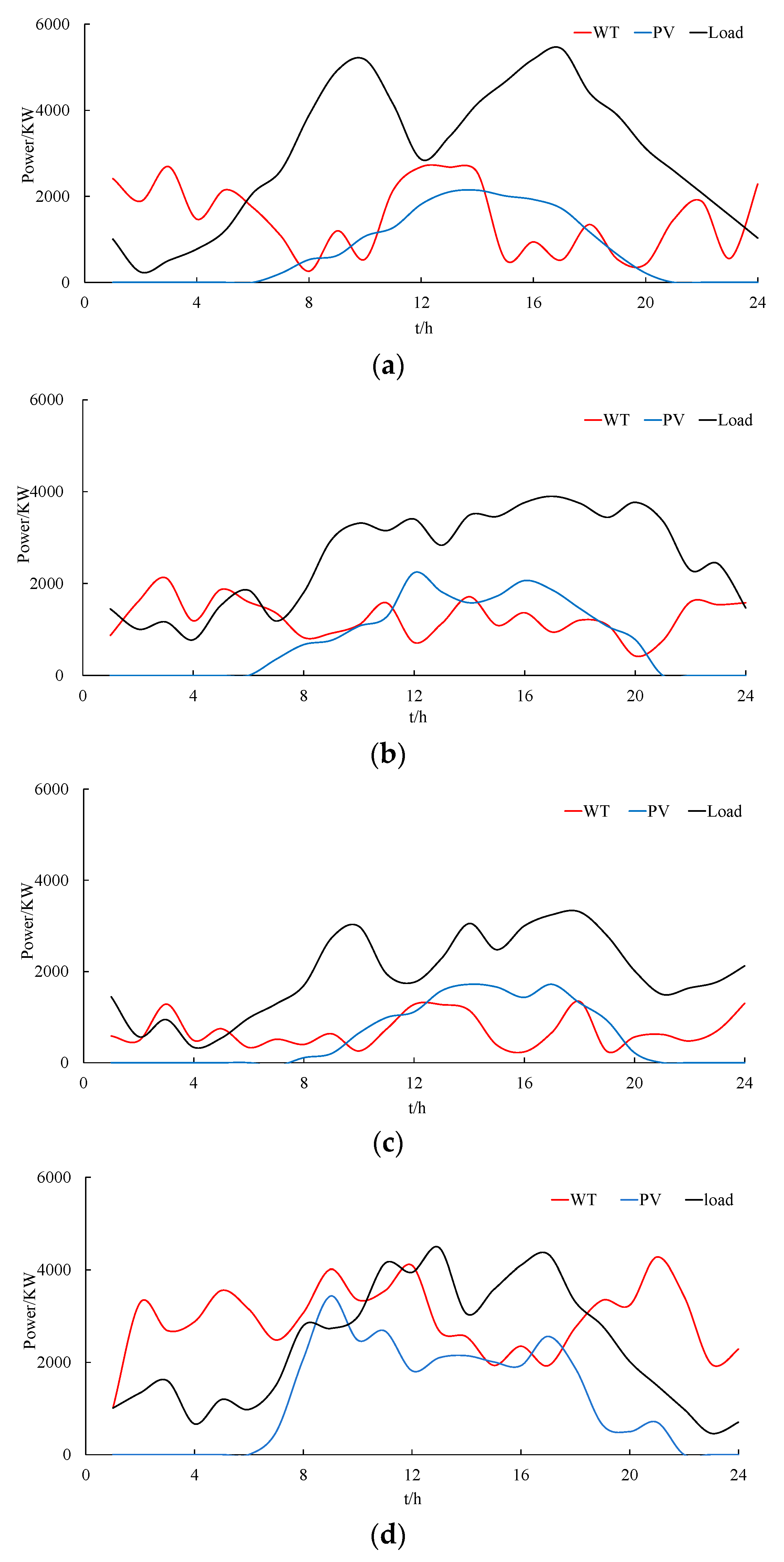
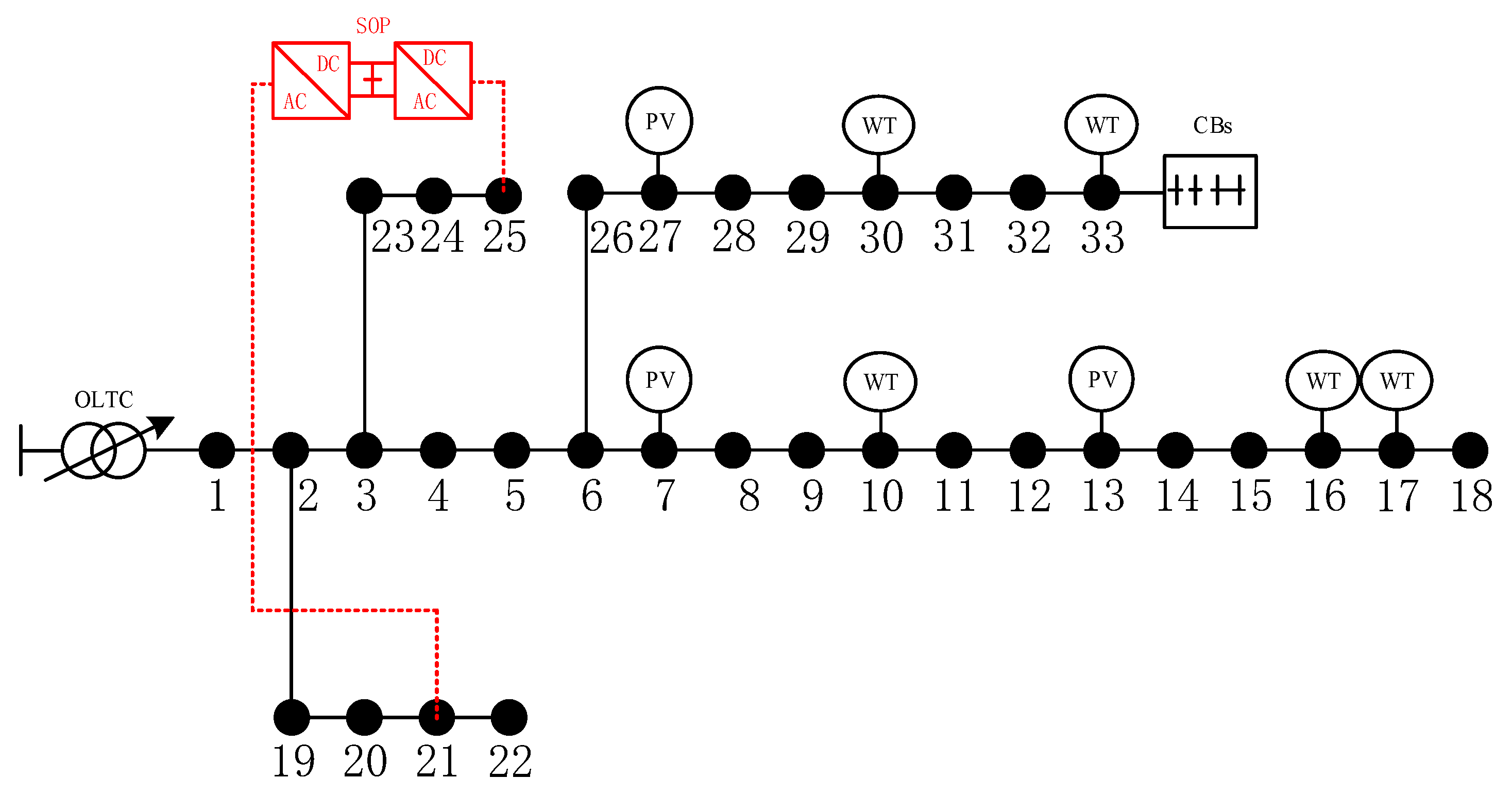



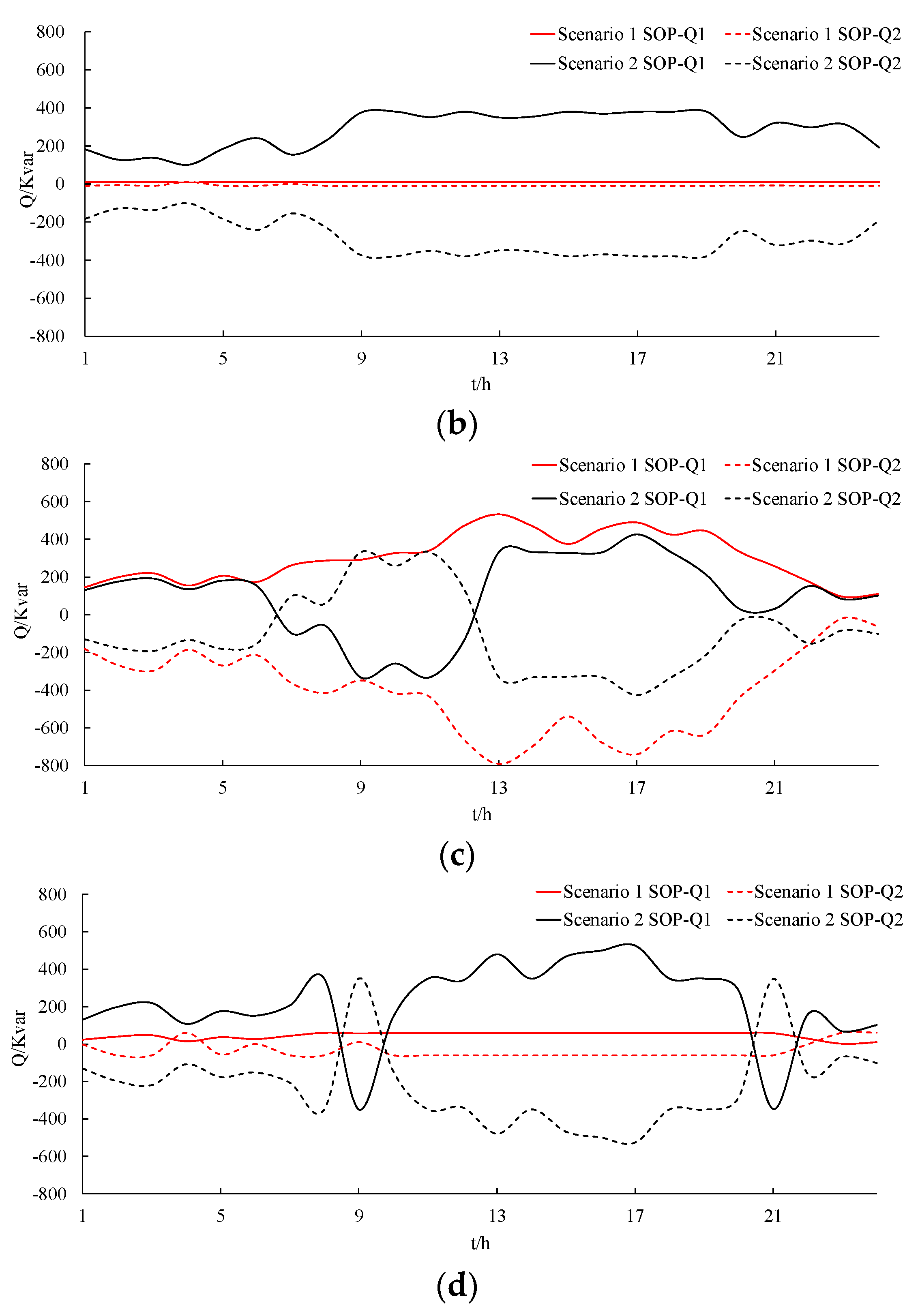
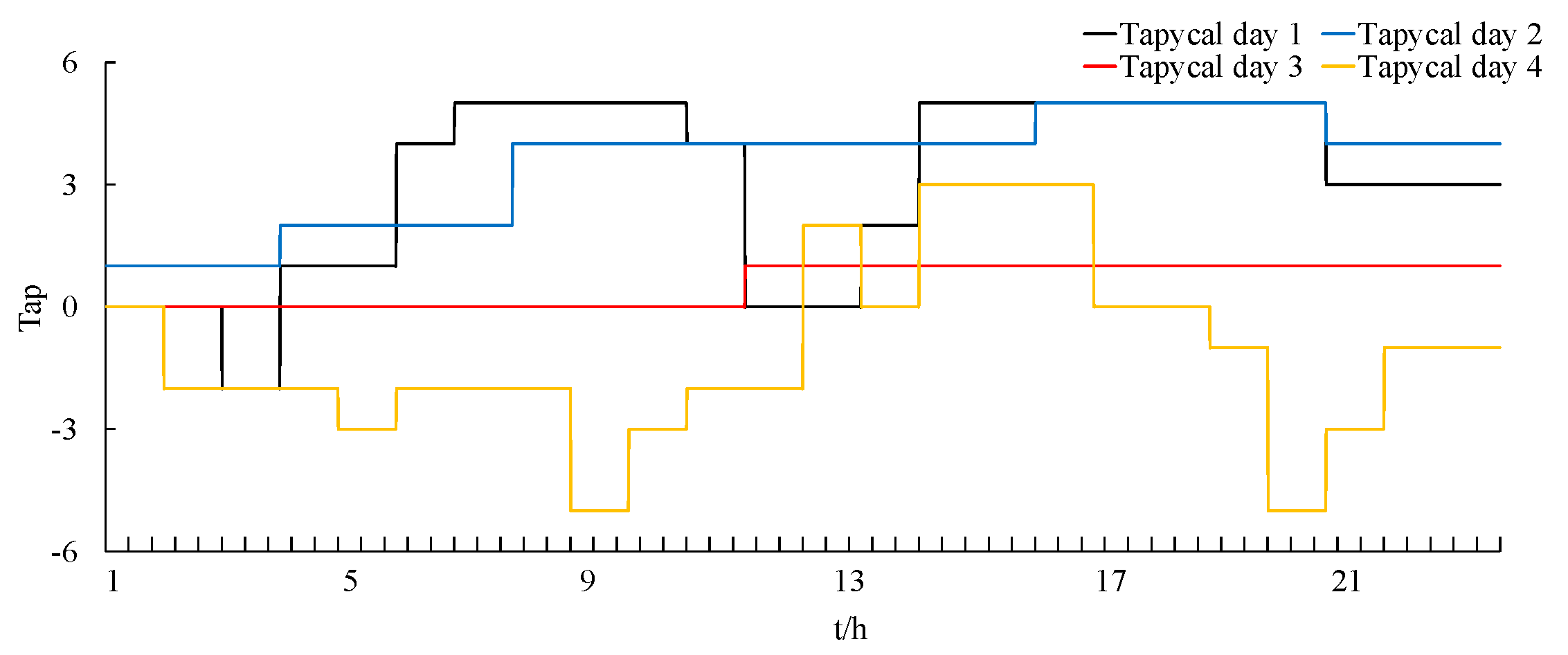
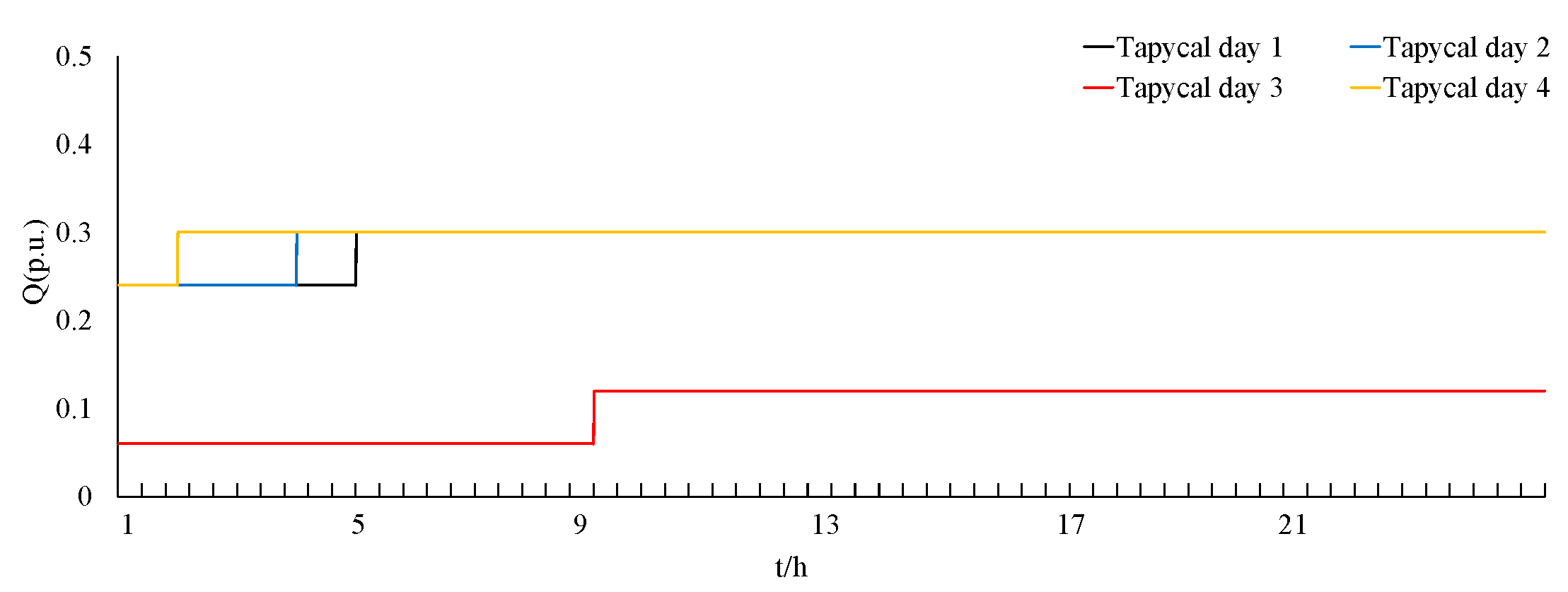
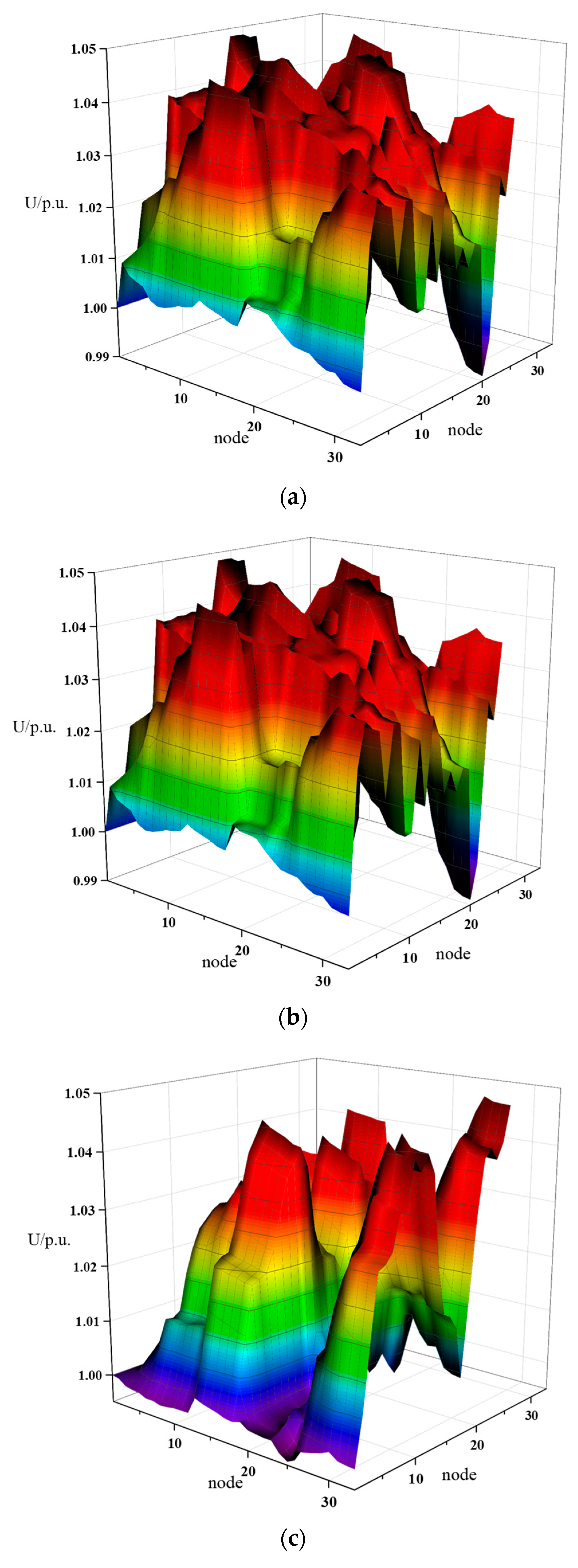

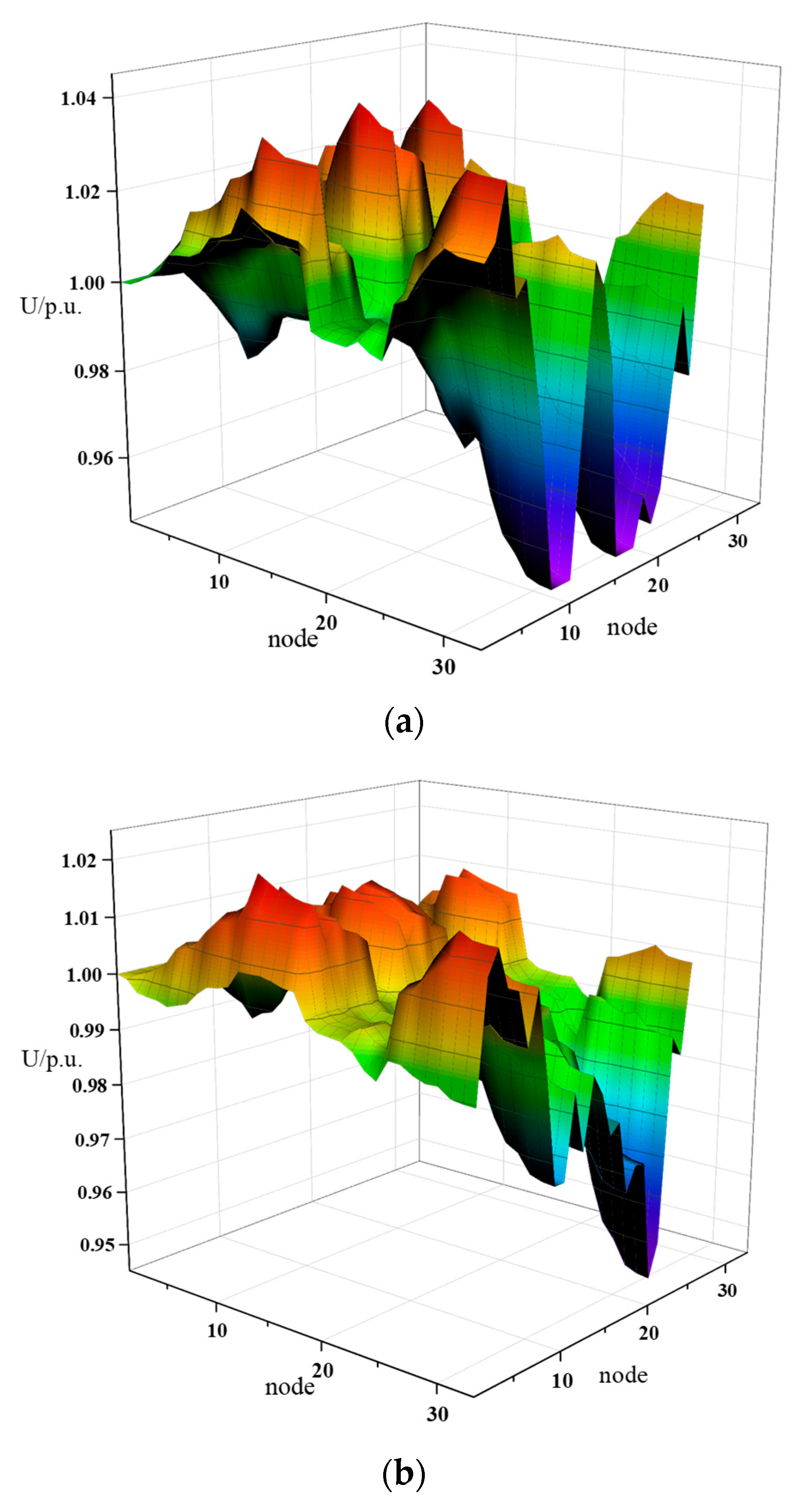
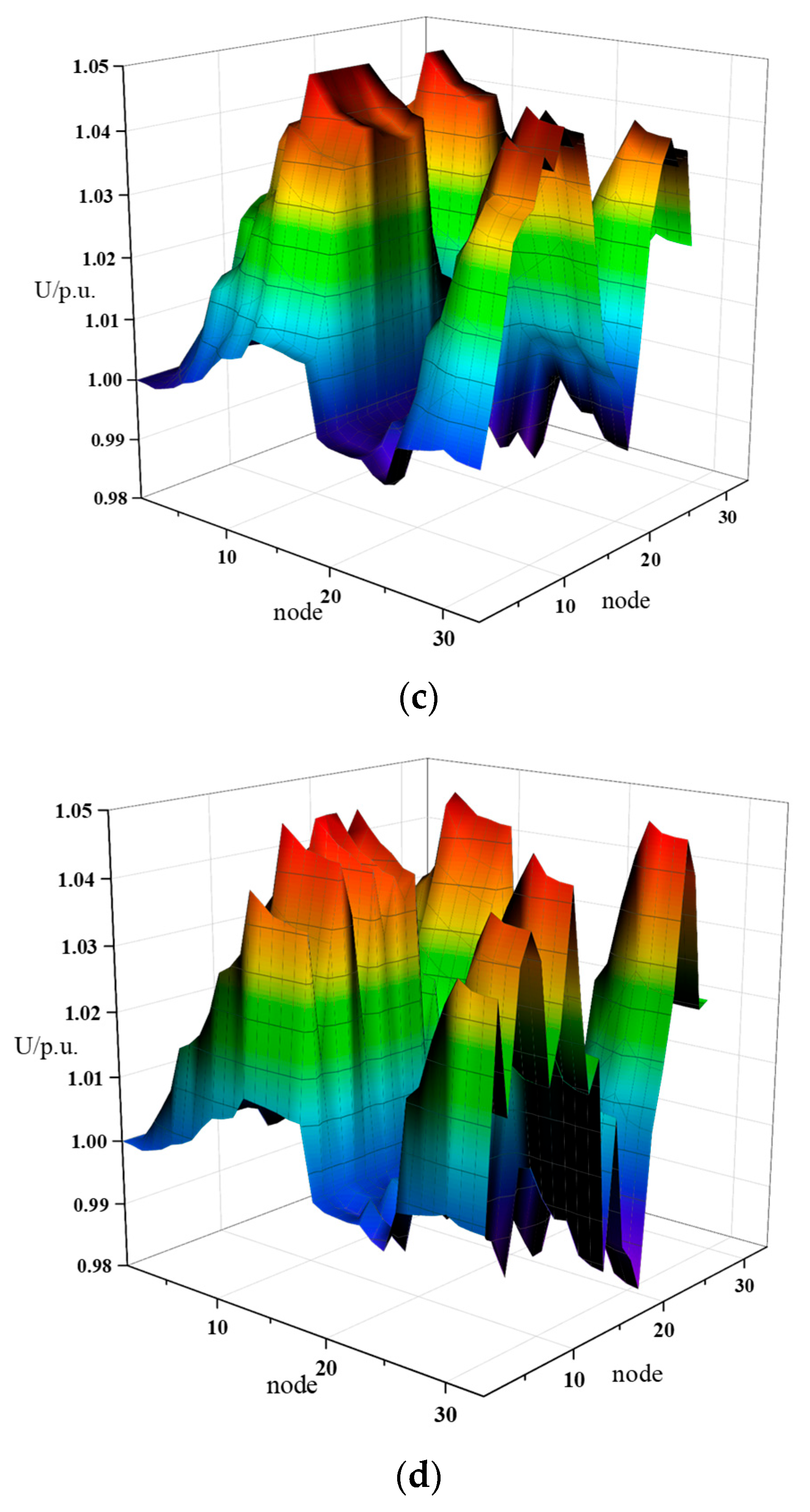
| Parameter | Typical Day 1 | Typical Day 2 | Typical Day 3 | Typical Day 4 | ||||
|---|---|---|---|---|---|---|---|---|
| Ordinary Node | Optimize Node | Ordinary Node | Optimize Node | Ordinary Node | Optimize Node | Ordinary Node | Optimize Node | |
| SOP capacity/KVA | 1540 | 1370 | 380 | 370 | 60 | 30 | 680 | 610 |
| Ct/104 ¥ | 15.68 | 13.95 | 3.87 | 3.76 | 0.61 | 0.31 | 6.92 | 6.21 |
| Cw/104 ¥ | 3.08 | 2.74 | 0.76 | 0.74 | 0.12 | 0.06 | 1.36 | 1.22 |
| Cs/104 ¥ | 19.11 | 15.93 | 9.51 | 8.93 | 34.73 | 5.54 | 37.45 | 32.75 |
| total cost/104 ¥ | 37.87 | 32.62 | 14.14 | 13.43 | 35.46 | 5.91 | 45.73 | 40.18 |
| Parameter | Typical Day 1 | Typical Day 2 | Typical Day 3 | Typical Day 4 | ||||
|---|---|---|---|---|---|---|---|---|
| Scenario 1 | Scenario 2 | Scenario 1 | Scenario 2 | Scenario 1 | Scenario 2 | Scenario 1 | Scenario 2 | |
| SOP capacity/KVA | 10 | 1370 | 10 | 370 | 10 | 30 | 60 | 610 |
| Ct/104 ¥ | 0.11 | 13.95 | 0.11 | 3.76 | 0.11 | 0.31 | 0.61 | 6.21 |
| Cw/104 ¥ | 0.02 | 2.74 | 0.02 | 0.74 | 0.02 | 0.06 | 0.12 | 1.22 |
| Cs/104 ¥ | 26.09 | 15.93 | 12.38 | 8.93 | 14.43 | 5.54 | 50.51 | 32.75 |
| Cswitch/104 ¥ | 33.36 | 0 | 9.36 | 0 | 11.77 | 0 | 44.36 | 0 |
| Total cost/104 ¥ | 59.58 | 32.62 | 21.87 | 13.43 | 26.33 | 5.91 | 95.6 | 40.18 |
Disclaimer/Publisher’s Note: The statements, opinions and data contained in all publications are solely those of the individual author(s) and contributor(s) and not of MDPI and/or the editor(s). MDPI and/or the editor(s) disclaim responsibility for any injury to people or property resulting from any ideas, methods, instructions or products referred to in the content. |
© 2025 by the authors. Licensee MDPI, Basel, Switzerland. This article is an open access article distributed under the terms and conditions of the Creative Commons Attribution (CC BY) license (https://creativecommons.org/licenses/by/4.0/).
Share and Cite
Cheng, Q.; Li, X.; Zhang, M.; Fei, F.; Shi, G. Optimal Configuration Strategy of Soft Open Point in Flexible Distribution Network Considering Reactive Power Sources. Energies 2025, 18, 529. https://doi.org/10.3390/en18030529
Cheng Q, Li X, Zhang M, Fei F, Shi G. Optimal Configuration Strategy of Soft Open Point in Flexible Distribution Network Considering Reactive Power Sources. Energies. 2025; 18(3):529. https://doi.org/10.3390/en18030529
Chicago/Turabian StyleCheng, Qiu, Xincong Li, Mingzhe Zhang, Fei Fei, and Gang Shi. 2025. "Optimal Configuration Strategy of Soft Open Point in Flexible Distribution Network Considering Reactive Power Sources" Energies 18, no. 3: 529. https://doi.org/10.3390/en18030529
APA StyleCheng, Q., Li, X., Zhang, M., Fei, F., & Shi, G. (2025). Optimal Configuration Strategy of Soft Open Point in Flexible Distribution Network Considering Reactive Power Sources. Energies, 18(3), 529. https://doi.org/10.3390/en18030529





